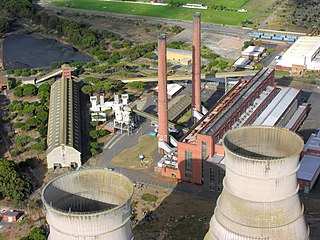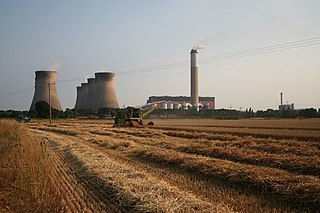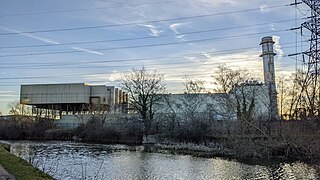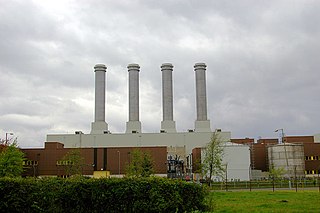
A power station, also referred to as a power plant and sometimes generating station or generating plant, is an industrial facility for the generation of electric power. Power stations are generally connected to an electrical grid.

A combined cycle power plant is an assembly of heat engines that work in tandem from the same source of heat, converting it into mechanical energy. On land, when used to make electricity the most common type is called a combined cycle gas turbine (CCGT) plant. The same principle is also used for marine propulsion, where it is called a combined gas and steam (COGAS) plant. Combining two or more thermodynamic cycles improves overall efficiency, which reduces fuel costs.

The Fort St. Vrain Nuclear Power Plant was a commercial nuclear power station located near the town of Platteville in northern Colorado in the United States. It operated from 1979 until 1989. It had a 330 MWe High-temperature gas reactor (HTGR). The plant was decommissioned between 1989 and 1992.

Peaking power plants, also known as peaker plants, and occasionally just "peakers", are power plants that generally run only when there is a high demand, known as peak demand, for electricity. Because they supply power only occasionally, the power supplied commands a much higher price per kilowatt hour than base load power. Peak load power plants are dispatched in combination with base load power plants, which supply a dependable and consistent amount of electricity, to meet the minimum demand.

The Moss Landing Power Plant is a natural gas powered electricity generation plant located in Moss Landing, California, United States, at the midpoint of Monterey Bay. Its large stacks are landmarks, visible throughout the Monterey Bay Area. The plant is owned and operated by Houston-based Dynegy and currently has a generation capacity of 1020 MW (net) from its two combined cycle generation units. It was once the largest power plant in the state of California, with a generation capacity of 2560 MW, before its two large supercritical steam units were retired in 2016.

The Huntly Power Station is the largest thermal power station in New Zealand and is located in the town of Huntly in the Waikato. It is operated by Genesis Energy Limited, a publicly listed company. The station has five operational generating units – three 250 MW coal-and-gas-fired steam turbine units, a 50 MW gas peaking plant, and a 403 MW combined cycle gas turbine plant. The station also plays an important role in voltage support for the Northland, Auckland and Waikato regions.
A load-following power plant, regarded as producing mid-merit or mid-priced electricity, is a power plant that adjusts its power output as demand for electricity fluctuates throughout the day. Load-following plants are typically in between base load and peaking power plants in efficiency, speed of start-up and shut-down, construction cost, cost of electricity and capacity factor.

Cottam power station is a decommissioned coal-fired power station. The site extends over 620 acres (250 ha) of mainly arable land and is situated at the eastern edge of Nottinghamshire on the west bank of the River Trent at Cottam near Retford. The larger coal-fired station, was decommissioned by EDF Energy in 2019 in line with the UK's goal to meet its zero-coal power generation by 2025. The smaller in-use station is Cottam Development Centre, a combined cycle gas turbine plant commissioned in 1999, with a generating capacity of 440 MW. This plant is owned by Uniper.
The Westinghouse Combustion Turbine Systems Division (CTSD), part of Westinghouse Electric Corporation's Westinghouse Power Generation group, was originally located, along with the Steam Turbine Division (STD), in a major industrial manufacturing complex, referred to as the South Philadelphia Works, in Lester, Pennsylvania near to the Philadelphia International Airport.
The Siemens Energy Sector was one of the four sectors of German industrial conglomerate Siemens. Founded on January 1, 2009, it generated and delivered power from numerous sources including the extraction, conversion and transport of oil and natural gas in addition to renewable and alternative energy sources. As of October 1, 2014, the sector level has been eliminated, including the Siemens Energy Sector.

The Littlebrook Power Station were a series of four oil and coal-fired power stations situated on the south bank of the River Thames, next to the Queen Elizabeth 2 Bridge and the Dartford Tunnel in Dartford, Kent. The final power station, Littlebrook D, ceased operating in March 2015, and has now been demolished.

Enfield Power Station is a 408 MW gas-fired station, opened on part of the original Brimsdown Power Station site on Brancroft Way at Brimsdown in the North London Borough of Enfield. It is near the A1055 and Lee Valley Park.
TenneT is a transmission system operator in the Netherlands and in a large part of Germany.

The Ōtāhuhu power station was a power station site located in Otara, Auckland, New Zealand. Two plants operated on the site: Ōtāhuhu A and Ōtāhuhu B. A proposed third station, Ōtāhuhu C, was never built. The stations were owned by Contact Energy.
Repowering is the process of replacing older power stations with newer ones that either have a greater nameplate capacity or more efficiency which results in a net increase of power generated. Repowering can happen in several different ways. It can be as small as switching out and replacing a boiler, to as large as replacing the entire system to create a more powerful system entirely. There are many upsides to repowering.
Termosolar Borges is a hybrid biomass-parabolic trough solar thermal power plant which provides electricity to Spain's transmission system. It is located about 100 kilometres (62 mi) west of Barcelona, about 10 kilometres (6.2 mi) south-east of Lleida, near Les Borges Blanques, Catalonia, Spain.

Killingholme B Power Station is a Combined‐cycle gas turbine natural gas power station in the civil parish of North Killingholme in North Lincolnshire, north of the Lindsey Oil Refinery, and adjacent to Killingholme A power station
The Hornsdale Wind Farm is an electricity generator in the locality of Hornsdale in the south-west of the Narien Range, north of Jamestown, South Australia. It consists of 99 wind turbines with a generation capacity of 315 megawatts (422,000 hp). The plant is owned and operated by Neoen, a French renewable energy company.
Caithness Long Island Energy Center is a 350 MW natural gas fired power power plant in Yaphank, New York on Long Island operated by Caithness Energy. It began operation in 2009 as the first major baseload plant to be built on Long Island in over 30 years, and by 2020 produced the second most net energy generated among power plants on Long Island. A proposal to construct a new unit tripling the capacity of the facility received initial approvals in 2013, but did not proceed and was shelved in 2018.
Bethpage Energy Center is a power station in Bethpage, New York, United States, consisting of two combined cycle plants opened in 1989 and 2005, and one gas turbine peaking plant opened in 2002. The original plant was commissioned by Grumman Aerospace for its Bethpage complex because it was deemed more cost-effective than purchasing power from electric utilities. It was acquired by Calpine in 1998, which expanded the facility with two more plants.












